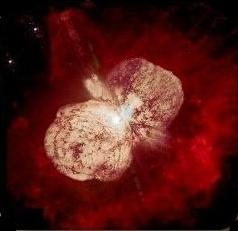HST Treasury Program and the Data Archive
Eta Carinae was selected as one of the first three HST Treasury programs in 2002. The Eta Car Treasury Program covered HST observations from 2002-2004. Eta Car has been observed with the STIS (Space Telescope Imaging Spectrograph) in every HST cycle since then. Consequently, there is a very large volume of spectra as well as imaging of Eta Car. We developed a special public archive for Eta Treasury Program. All the spectra from 1998 to the present are included here.
Special processing techniques, archive, and original website were devised by K. Davidson, J.C. Martin, M. Gray, and M. Koppelman.
The Data Archive
The STIS/CCD detector -- arguably the most powerful instrument on HST for astrophysics -- has 0.05-arcsec pixels, somewhat too large for the telescope's spatial resolution. This seemingly minor mismatch creates serious trouble for data reduction. If one tries to achieve resolution better than 0.3 arcsec, STScI's software creates subtle errors in the reduced spectrum. Mathematically the STIS/CCD data contain enough information for 0.1 arcsec resolution, but the standard software are too simple. Instead we must subdivide the pixels and follow steps explained in []. STScI later introduced some optional modifications in the data reduction, but did not subdivide the pixels -- a mathematically crucial detail.
The improved technique was necessary for our 2003 Treasury Program, because Eta Carinae's main problems need resolution better than 0.2 arcsec. Resulting output spectrograms differ in several respects from those in the STScI/HST archive, and users would need information about the non-routine processing. Hence a separate archive was desirable.
Another concern for archiving is the large number of spectrograms. Since Eta Car is very bright, STIS obtained far more data per orbit than in a normal HST program. Slit positions differed by 0.1-0.5 arcsec for intricate reasons, many slit orientations were eventually sampled, and other parameters varied. The resulting spectra often resemble each other, but differ subtly because of those parameters. STScI's archive is not well adapted to this situation; we need a convenient apparatus for sorting the hundreds of Eta observations, identifying which of them fits a particular purpose, etc. The archive permits selection not only by date and wavelength but also by slit orientation and phase in the 5.5 yr cycle.
A description of the sub-pixel modeling for the spectral reduction is provided here in the technical memos section and the software delevoped for handling the spectra is given here.
A link to the data archive is located here.Original Treasury Team Members (2002)
- Kris Davidson (PI), University of Minnesota
- T.R. Gull, Goddard Space Flight Center, NASA
- K. Ishibashi, M.I.T.
- D. John Hillier, University of Pittsburgh
- Roberta Humphreys, University of Minnesota
- Augusto Damineli, University San Paulo, Brazil
- Michael Corcoran, Goddard Space Flight Center, NASA
- Otmar Stahl, Landessterwarte, Heidelberg, Germany
- Kerstin Weis, University of Bochum, Germany
- Sveneric Johansson, Lund University, Sweden
- Fred Hamann, University of Florida
- Nolan Walborn, Space Telescope Science Institute
- Manuel Bautista, Inst. Venezolano Invest. Cientifica, Venzuela
- Henrik Hartman, Lund University, Sweden

